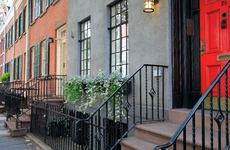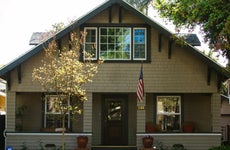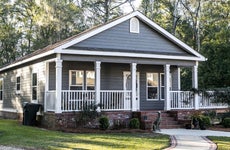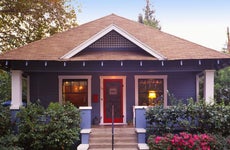What is a split-level house?
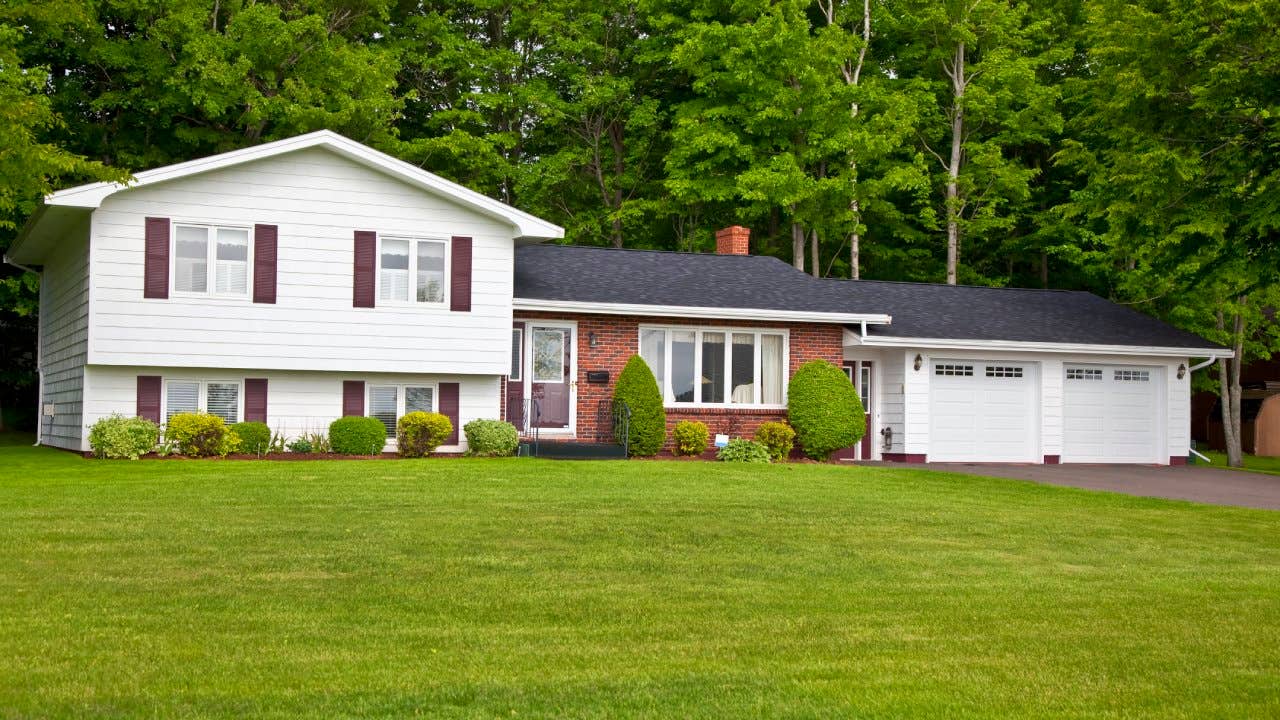
The Bankrate promise
At Bankrate we strive to help you make smarter financial decisions. While we adhere to strict , this post may contain references to products from our partners. Here's an explanation for .
It’s the quintessential style of suburban America. You’d instantly know it if you saw it: a house with staggered levels (more or less obvious from the outside) connected via short flights of stairs.
Geared toward the burgeoning baby-boom generation, the split-level house flourished in newly built neighborhoods all over the country in the mid-1900s. These single-family homes might not be as popular today, but there are still plenty of them around — and they have their advantages, even if you aren’t a maven of midcentury modern style.
Let’s take a retro tour.
What characterizes a split-level house?
As their name implies, split-level homes have more than one floor, but not all run the full length of the house. Instead, they’re characterized by several staggered levels, each linked by a separate staircase. “There are generally two sets of stairs off the home’s main story, leading upstairs to bedrooms and downstairs to the basement,” explains Marina Vaamonde, owner and founder of HouseCashin, a platform that connects home sellers and real estate investors.
Some styles of split-levels have a garage on the lower level, with a half-basement leading into it, and bedrooms located above it.
This is not to be confused with a split-foyer or split-entry house, which requires you to walk up or down the stairs as soon as you enter through the front door to get to the various rooms. With a split-level house, you generally enter on the ground floor, which contains much of the major living space (kitchen, living room, etc.). On one side, there is a half-flight of stairs leading up or down to the next level.
Split-level homes are also often referred to as tri-levels, three being the standard number of floors they contained — though some had four or even five.
External features
While they can be built in different architectural styles, split-level homes generally share certain salient characteristics. On the outside, they typically feature:
- Asymmetrical silhouettes (rectangular main level, squarer or protruding section containing the upper level)
- Double-hung windows
- Large picture windows on the main level
- Low-pitched roofs
- Mixed-material facades (especially brick and wood)
- Two to eight exterior steps leading to the front door
Internal features
The interior design of split-level houses can vary considerably. But — in addition to their mini-stairways — they frequently feature:
- Vaulted ceilings (top story)
- Separate living, dining and kitchen rooms on the main floor; bedrooms on upper floor
- Finished basements
- Attached or built-in garages
- Multiple attic spaces and storage areas
- Minimal ornamental features (moldings, cornices, etc.)
- Large patio doors/sliders leading off the main living area
History of the split-level house
Split-levels are essentially a variation on the single-story ranch home that developed in the early 20th century. They “are influenced by midcentury modern architect Frank Lloyd Wright’s single-story, open-concept prairie homes, dividing the ‘public’ and ‘private’ rooms by half levels,” says Kerry Sherin, consumer advocate of Ownerly, a home valuation company.
They came into their own after World War II, with the rise of suburban developments catering to the baby-boom explosion of young, growing families. With its staggered levels, the style was highly practical for packing into limited land parcels, allowing for lots of living space plus a backyard.
“Split-level homes, which first appeared in American suburbs in the 1950s and 1960s, gave homebuilders the chance to cram more square footage into a smaller and more affordable lot,” says Dino DiNenna, a Hilton Head Island, South Carolina real estate broker. They were especially prevalent in hilly terrains, as they could be constructed directly into bedrock, rather than having to level the land or make other adjustments.
With its open landings and floors, the style also seemed refreshingly airy, spacious and “modern” to home dwellers, compared to dark, tiny-roomed apartments or narrow townhouses. Though the standard split-level was technically only two stories, it often felt like more, due to all the different levels.
The design’s popularity peaked in the 1960s and 1970s, coinciding with the TV show The Brady Bunch, which showcased the blended family living in a split-level house. After that, it began to seem dated and unimaginative, as architects embraced completely open layouts or revived historic architectural styles.
Although not nearly as popular today, split-level homes are still being built. They’re especially common in states with mountainous or uneven terrain. “Southwestern states like Arizona, Nevada, New Mexico and also parts of Southern California have the biggest concentrations of split-level houses, which continue to be inhabited today,” states Daniela Andreevska, real estate expert at Mashvisor, a real estate investment data analysis service.
Different types of split-level houses
There are several types of split-level homes available. The key difference is often their exterior appearance — that is, how obvious the staggered levels are from a curbside view.
Standard split
A standard split-level home typically has a ground level entrance door leading into the main floor. A short set of stairs divides the other levels. The bottom level features a playroom, den, family room or garage, while the upper floor has bedrooms and bathrooms. “This type generally contains open floor plans, covering a fairly small footprint,” says Vaamonde.
Side split
Perhaps the most popular variety is the side split (it’s the one featured in The Brady Bunch). It showcases all three levels from the front, with the bedrooms stacked on top of the basement floor on one side and the main floor on the other side.
Back split
“The layout of a back-split ranch is almost identical to that of a side split, with one significant exception: it has been rotated 90 degrees,” says Mike Gregor, a Realtor with Cohen Agency SiM in New Hartford, Connecticut. “A back-split level home will appear to have a single story when viewed from the curb, similar to a ranch-style home.”
Stacked split
The stacked split-level house has at least four floors, with the additional floor over top the main living area. There are several flights of stairs connecting each level from the main staircase. The upper floor typically has accessory rooms like an informal living area, with a garage on the bottom floor.
What do split-level homes cost?
If you’re building, a split-level is a more economical choice than a traditional two-story home, as it uses fewer materials and is less labor-intensive to build, says Jennifer Spinelli, founder and CEO of Watson Buys in Denver.
According to Joshua Haley, founder of Moving Astute, “the average cost to build a split-level home is about $100 per square foot and they typically sell for about 10 percent more than their construction costs.” That $100-per-square-foot figure is on the low end for new home construction.
If you’re buying, split-levels are also often a bargain. The supply is ample and, frankly, they’re rather unfashionable: The current revival in 1970s style doesn’t extend to these tract-houses. “In many communities with million-dollar homes, a split-level may be purchased for $600,000 to $750,000,” even with cosmetic upgrades and latest infrastructure updates, Sherin says.
However, bear in mind that many split-levels may not have aged well: The youngest of them are 50-something, and they were often mass-produced properties, meant to be built quickly and economically for the middle market. Also, if you’re seeking financing, Sherin points out that split-level houses may not appraise as high as similar-sized non-split-level homes, due to their substantial amount of subterranean livable space (which is lower-valued square footage, if it’s valued at all).
Final word on split-level houses
Split-level houses do have their drawbacks. They have limited natural light, can feel poky and look dated, especially to eyes used to the spacious flow of contemporary, open-floor plans and floor-to-ceiling windows. Their numerous steps mean they may not be the best for the elderly or those with mobility issues. Their layouts can be challenging to convert, too.
On the plus side, a split-level can appeal to homebuyers wanting separate living and sleeping quarters (as hybrid work arrangements continue, designated rooms are definitely making a comeback). Though rarely high-prestige properties, split-levels are usually solid builds, are well-located, and offer good value at current prices. Now as then, they can work for young families seeking the proverbial starter home.
In short, a split-level house can provide a lot of living space for the money and the size. And that’s something that never goes out of style.
Related Articles
